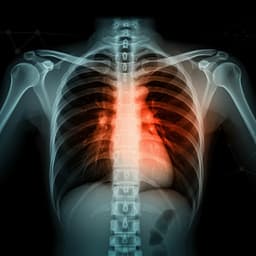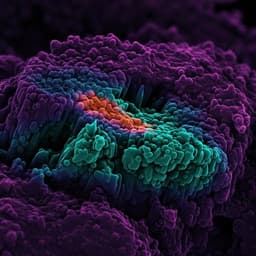
Biology
Multielement Z-tag imaging by X-ray fluorescence microscopy for next-generation multiplex imaging
M. Strotton, T. Hosogane, et al.
Discover the groundbreaking multielement Z-tag X-ray fluorescence (MEZ-XRF) bioimaging method developed by Merrick Strotton, Tsuyoshi Hosogane, Marco di Michiel, Holger Moch, Zsuzsanna Varga, and Bernd Bodenmiller. This innovative technique allows for rapid, high-resolution imaging of subcellular features, marking a significant advancement in multiomic tissue analysis.
~3 min • Beginner • English
Introduction
The study addresses the need for a single imaging platform that is nondestructive, highly multiplexed, and scalable from tissue-level to subcellular resolution. Conventional fluorescence microscopy is limited by spectral overlap, diffraction, autofluorescence (notably in FFPE tissues), and often requires destructive or iterative workflows that constrain throughput and re-imaging. Other multiplexed platforms (IMC, MIBI, MALDI, spatial sequencing) are limited by surface imaging, destructiveness, or lower spatial resolution/sensitivity. The authors hypothesize that X-ray fluorescence microscopy with element-based reporters (Z-tags) can overcome these constraints, enabling parallel detection of many targets at multiple scales without destroying samples, and that SABER amplification can further enhance sensitivity and speed.
Literature Review
- Fluorescent imaging is constrained by spectral crowding, diffraction limits, autofluorescence in FFPE, and typically trades multiplexing for speed/resolution. Iterative staining and nucleotide barcoding expand plex but are slow, potentially destructive, and often require high-resolution imaging for barcode separation.
- Electron microscopy achieves ultrastructure but with low throughput and limited multiplexing.
- MALDI imaging is unbiased and high-plex but with low-micrometer resolution and low sensitivity.
- IMC and MIBI enable 40+ markers via mass tags but are destructive (except MIBI to some extent) and largely surface/2D; 3D requires serial sections.
- Sequencing-based spatial methods and fluorescent readouts inherit physical limits of fluorescence.
- Prior XRF work showed single-marker detection using gold nanoparticles or quantum dots, but multiplexed XRF imaging had not been achieved. The authors position MEZ-XRF to leverage X-ray penetrance and discrete elemental emissions for multiplexed, nondestructive imaging across scales.
Methodology
- Reagents and labeling: Antibodies were conjugated to metal-chelating polymers (Maxpar X8) to create Z-tags based on lanthanides and select elements. For SABER amplification, antibodies were conjugated to DNA bridge sequences; concatemerized DNA (SABERx1/x2) was hybridized, then element-tagged imager strands were applied to exponentially increase metal load per target.
- Samples: FFPE sections from epithelial cell lines (MCF10a, A431, ZR-75-1, SKBR3) and human tissues (breast tumors—HER2+, luminal A, luminal B HER2−/+, tonsil, appendix). Sections were 4 µm thick on glass or Mylar film. Some cells were pulsed with IdU; Ir or Rh DNA intercalators used for nuclei; Ag counterstain tested initially.
- XRF imaging: Conducted at ESRF beamline ID15A using a 69 keV X-ray beam focused to 500 × 500 nm (Kirkpatrick–Baez optics). Raster scanning at step sizes of 0.5 µm (high-resolution ROI) or 2–4 µm (overviews) with dwell rates from 1–1,500 Hz. Detectors: silicon drift detectors (SDD) and germanium GeCMOS/GeCMOS2 with calibration via La Kα1. K-shell emissions were chosen for better spectral separation among lanthanides and reduced line overlap compared with L-lines.
- Sensitivity benchmarking: Eight-point gelatin standards (0–200 ppm per element) were imaged to determine limits of detection (LOD) at various raster rates and detectors; compared directly with IMC acquired at 200 Hz and 500 nm pixels.
- Image processing: Spectral deconvolution to element emission line maps using PyMCA; normalization to beam fluctuations and Compton scatter; data organized in custom HDF containers. Single-cell segmentation with Mesmer (DeepCell) using nuclear and membrane/cytoplasmic channels; single-cell intensities extracted (Steinbock), analyzed with Scanpy (UMAP, Leiden clustering). Subcellular localization assessed by nuclear vs nonnuclear intensity ratios.
- Comparative imaging: Matched regions subsequently imaged by IMC (Hyperion/CyTOF) for cross-validation. H&E staining performed post XRF to demonstrate nondestructive compatibility.
- Multiscale workflows: Large-area overview scans at high speed/low sensitivity to guide selection of ROIs, followed by slower, high-sensitivity subcellular scans; demonstration on breast cancer, tonsil, and appendix sections with timing and step-size parameters.
Key Findings
- Detector and sensitivity:
- K-shell MEZ-XRF using GeCMOS2 achieved sub-parts-per-million detection for 16 lanthanides at 10 Hz, with spectral resolution ~355 eV at La Kα (SDD ~360 eV), enabling parallel separation of neighboring lanthanides.
- Detection limits of K-shell MEZ-XRF were comparable to IMC (200 Hz) after correcting for isotope abundances.
- Multiplexed imaging and cytometry:
- Parallel imaging of up to 20 Z-tags/SABER Z-tags at subcellular resolution in cell lines and human tissues.
- Cell lines exhibited expected marker profiles (e.g., EGFR high in A431, HER2 in SKBR3, CK8/18 in ZR-75-1, CK5 in MCF10a); IdU only in pulsed ZR-75-1; pHH3 enrichment in proliferating A431.
- Single-cell intensities of duplicate-conjugated antibodies were highly correlated; subcellular localization patterns matched expectations (nuclear HH3/pHH3/ER; membrane/cytoplasmic CKs, EGFR, HER2, CD44).
- Leiden clustering separated cell types and states (e.g., pHH3+ A431, IdU+ ZR-75-1) with consistency between MEZ-XRF and IMC.
- Tissue phenotyping and nondestructive multiscale imaging:
- Fast overview scans (e.g., 20 Hz, 2 µm steps) detected abundant and some low-abundance markers; higher-sensitivity ROI scans (e.g., 5 Hz, 0.5 µm steps) refined subcellular localization (e.g., HER2 membrane localization) and confirmed low-level targets.
- In breast tumors, clusters reflected expected phenotypes (HER2−/ER+, HER2+/ER+, stromal), with spatially coherent localization.
- Subcellular localization quantified from ROI scans matched known biology (nuclear HH3/pHH3/ER/Ki-67; membrane/cytoplasm for CKs, CD44, HER2; cytoplasmic vimentin/SMA).
- Speed and sensitivity gains with SABERx2 and GeCMOS2:
- SABERx2 increased signal-to-noise 10–100× over standard Z-tags, enabling detection of low-abundance targets (e.g., PR, PD1, CTLA4, CD3/CD4/CD8) and ultrafast imaging.
- With SABERx2, clear marker detection was maintained up to 1.5 kHz raster rates; raster speed capped by software readout latency.
- MEZ-XRF at 10 Hz with GeCMOS2 showed signal-to-noise equivalent to 200 Hz IMC for standard tags; SABERx2 further improved both.
- Multiscale correlative imaging workflow:
- Breast cancer overview: 1 cm² at 200 Hz, 4 µm steps (~8.7 h) guiding a 400 µm² ROI at 5 Hz, 0.5 µm steps (~8.8 h), revealing additional markers.
- Tonsil overview: 5 mm² at 100 Hz, 4 µm steps (~4.3 h), ROI of CD11c-rich follicle imaged at higher sensitivity.
- Appendix: 5 mm² overview at 100 Hz, 4 µm steps (~4.3 h), CD20-rich ROI at 25 Hz, 0.5 µm steps (~10.7 h); subsequent IMC confirmed comparable localization and SNR after artifact filtering.
- Nondestructive compatibility:
- Samples remained suitable for H&E post XRF (minor eosin bleaching in ROI area), and for subsequent IMC; MEZ-XRF enabled repeat imaging and cross-modality alignment.
Discussion
MEZ-XRF introduces a nondestructive, highly multiplexed imaging platform leveraging discrete elemental K-shell emissions to overcome the spectral crowding and diffraction limits of fluorescence and the destructiveness/surface restriction of mass/ion-based imaging. The approach spans tissue to subcellular scales within one platform and, when combined with SABERx2, reaches kHz imaging speeds while maintaining sensitivity comparable to or exceeding IMC under matched conditions. This enables new study designs: multiplexed overview scans to identify rare cell niches or features, followed by targeted, high-sensitivity ROI imaging; integration with histology and potentially spatial omics on the same section; and opportunities to combine mass-tag multiplexing with emerging fluorescent or barcode strategies. The platform’s scalability and re-imaging capability provide robust cytometric analyses with spatial context, as validated by concordance with IMC in phenotype identification and marker localization. Improvements in X-ray source flux, detector solid angle/arrays, and multi-beam scanning could further increase throughput and sensitivity, and K-line strategies are well-positioned for future 3D implementations given excellent tissue penetrance.
Conclusion
The study establishes MEZ-XRF as a next-generation, nondestructive, multiplexed imaging modality capable of parallel detection of tens of molecular targets at subcellular resolution across large tissue areas. Using K-shell XRF with optimized germanium detection and SABERx2 amplification, MEZ-XRF achieves sub-ppm sensitivity, matches or surpasses IMC sensitivity, detects low-abundance immune and receptor markers, and attains ultrafast raster speeds up to 1.5 kHz. The method enables multiscale workflows (overview-to-ROI), retains compatibility with downstream H&E and IMC, and supports robust single-cell and subcellular analyses. Future directions include: increasing flux and detector acceptance for speed/sensitivity gains; multi-beam scanning; expanding element channels and integrating endogenous element imaging; adapting for high-resolution/3D imaging; and combining with barcode-based or iterative Z-tag strategies for even higher multiplexing.
Limitations
- Access and instrumentation: High-energy K-line XRF currently requires synchrotron beamlines and specialized optics; broader adoption may rely on advanced laboratory sources or L-line strategies with ultra–high-resolution detectors.
- Detector-specific issues: Germanium detectors can exhibit stronger escape peaks (handled via deconvolution) and higher background due to Compton scatter, particularly in higher-Z channels; MEZ-XRF backgrounds are not thresholded like IMC, yielding nonzero background distributions.
- Element- and detector-dependent sensitivity: LOD varies by element and detector; panel design should place abundant markers in weaker channels. Dual-detector (SDD + Ge) strategies may broaden optimal energy coverage.
- Speed constraints: Software latency in spectral readout limited maximal raster rates (1.5 kHz ceiling in this setup).
- 3D imaging readiness: While K-line penetration is favorable, practical 3D MEZ-XRF requires faster acquisition and robust 3D labeling protocols.
- Comparative analyses: Small differences in field overlap, resolution, and channel sensitivity between MEZ-XRF and IMC affected one-to-one cell matching; some very low-abundance markers were only detected by IMC in specific instances.
- Minor sample effects: Post-XRF H&E showed localized eosin bleaching in ROI areas, though nuclei remained identifiable.
Related Publications
Explore these studies to deepen your understanding of the subject.







